Race and Social Class Impact on Education: A Pilot Study
VerifiedAdded on 2022/08/12
|17
|3842
|42
Project
AI Summary
This assignment presents a pilot study investigating the impact of race and social class on education within UK universities. The study explores the concept of racism in educational institutions, examining its effects on student efficiency and the correlation between racist activities and the quality of education. The research includes a literature review covering factors affecting racial and social discrimination, the impact of racism on education, and the quality of education imparted. The methodology section outlines the research philosophy, approach, design, and data collection methods. The student aims to identify the concept of racism in educational institutions, examine the impact of racism on educational efficiency, evaluate the correlation between racism and the quality of education, and suggest activities to minimize the impact of racism. The study also includes research questions, a hypothesis, and references. The assignment demonstrates an understanding of research methodologies, ethical considerations, and the complexities of race and education in the context of higher education.
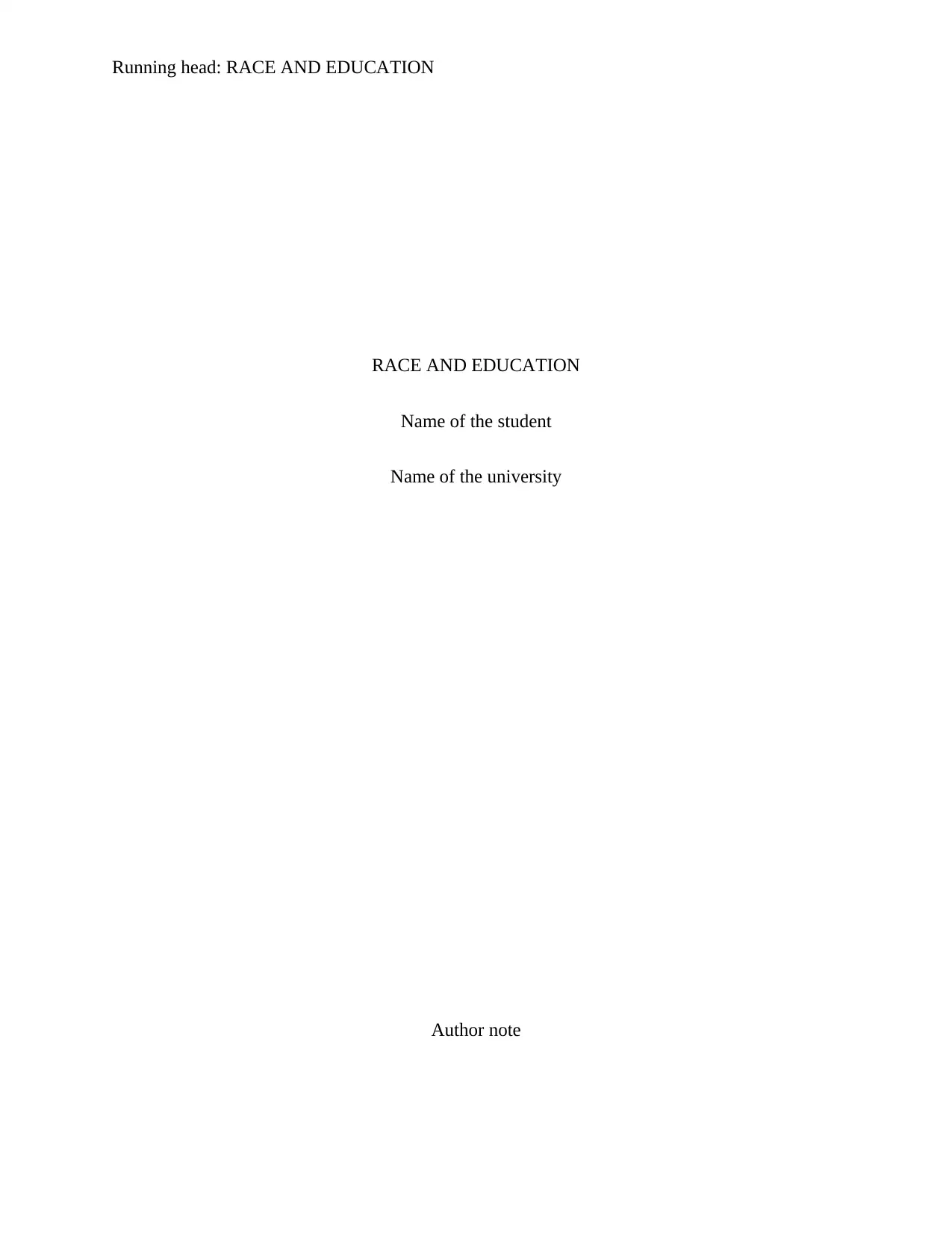
Running head: RACE AND EDUCATION
RACE AND EDUCATION
Name of the student
Name of the university
Author note
RACE AND EDUCATION
Name of the student
Name of the university
Author note
Paraphrase This Document
Need a fresh take? Get an instant paraphrase of this document with our AI Paraphraser
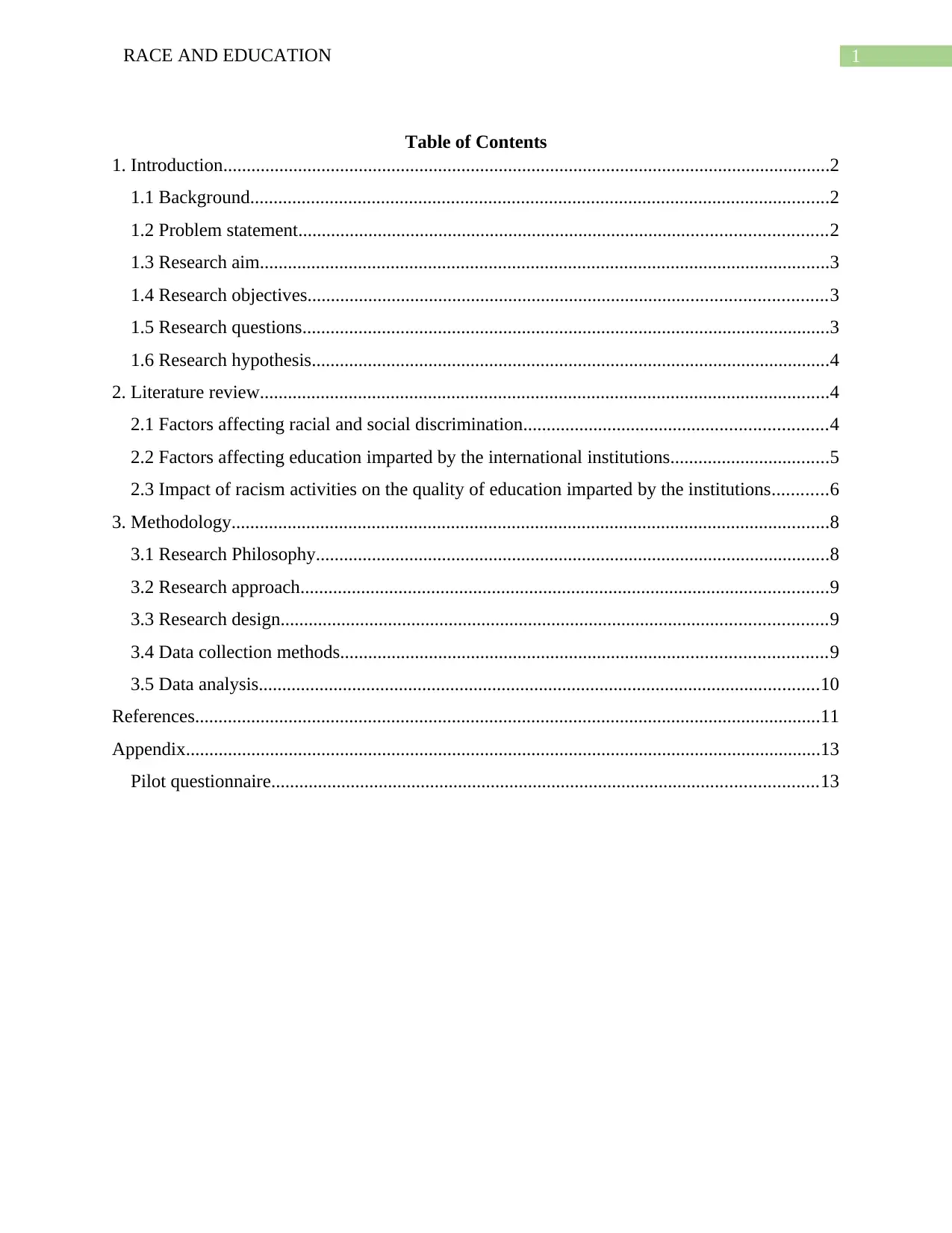
1RACE AND EDUCATION
Table of Contents
1. Introduction..................................................................................................................................2
1.1 Background............................................................................................................................2
1.2 Problem statement.................................................................................................................2
1.3 Research aim..........................................................................................................................3
1.4 Research objectives...............................................................................................................3
1.5 Research questions.................................................................................................................3
1.6 Research hypothesis...............................................................................................................4
2. Literature review..........................................................................................................................4
2.1 Factors affecting racial and social discrimination.................................................................4
2.2 Factors affecting education imparted by the international institutions..................................5
2.3 Impact of racism activities on the quality of education imparted by the institutions............6
3. Methodology................................................................................................................................8
3.1 Research Philosophy..............................................................................................................8
3.2 Research approach.................................................................................................................9
3.3 Research design.....................................................................................................................9
3.4 Data collection methods........................................................................................................9
3.5 Data analysis........................................................................................................................10
References......................................................................................................................................11
Appendix........................................................................................................................................13
Pilot questionnaire.....................................................................................................................13
Table of Contents
1. Introduction..................................................................................................................................2
1.1 Background............................................................................................................................2
1.2 Problem statement.................................................................................................................2
1.3 Research aim..........................................................................................................................3
1.4 Research objectives...............................................................................................................3
1.5 Research questions.................................................................................................................3
1.6 Research hypothesis...............................................................................................................4
2. Literature review..........................................................................................................................4
2.1 Factors affecting racial and social discrimination.................................................................4
2.2 Factors affecting education imparted by the international institutions..................................5
2.3 Impact of racism activities on the quality of education imparted by the institutions............6
3. Methodology................................................................................................................................8
3.1 Research Philosophy..............................................................................................................8
3.2 Research approach.................................................................................................................9
3.3 Research design.....................................................................................................................9
3.4 Data collection methods........................................................................................................9
3.5 Data analysis........................................................................................................................10
References......................................................................................................................................11
Appendix........................................................................................................................................13
Pilot questionnaire.....................................................................................................................13

2RACE AND EDUCATION
Topic: Impact of Race and Social Class on Education: Analysis of UK universities
1. Introduction
1.1 Background
The race and social classification posed a serious impact on the educational systems
while inducing inequality of treatments. The black and minority ethnic (BME) has been one of
the major concerns that are being faced by the educational organizations while increasing racism
related operations. According to a research made by Warmington (2020), the racial minority
groups or people belonging to lower income families have minimal scope for higher education. It
has been notice through a study that more than 43% of the students encounter instances of racial
discrimination while pursuing with their academic careers (Kuhl et al. 2019). On the contrary,
the increased trend of migration among the students while pursuing their higher education in
reputed international universities have maximized the exposure of students to racism (King and
Chandler 2016). Therefore, the research will aim at identifying the impact of racial
discriminations on the quality of education that is being imparted by the international institutions
to the students.
1.2 Problem statement
Racial discrimination in the context of education have increased considerably through the
growing trend of migration among the students to the foreign countries for pursuing higher
education. Parsons (2019) stated that the racism based discrimination demoralizes the initiatives
that are undertaken by a BME. Again, Levy et al. (2016) argued that the concept of racism in
educational field is specifically based on the concept that the students are not exposed to
standardized knowledge which might create differences in the class of students. The concept of
slow learning has brought about significant changes to the institutional effect that is being
Topic: Impact of Race and Social Class on Education: Analysis of UK universities
1. Introduction
1.1 Background
The race and social classification posed a serious impact on the educational systems
while inducing inequality of treatments. The black and minority ethnic (BME) has been one of
the major concerns that are being faced by the educational organizations while increasing racism
related operations. According to a research made by Warmington (2020), the racial minority
groups or people belonging to lower income families have minimal scope for higher education. It
has been notice through a study that more than 43% of the students encounter instances of racial
discrimination while pursuing with their academic careers (Kuhl et al. 2019). On the contrary,
the increased trend of migration among the students while pursuing their higher education in
reputed international universities have maximized the exposure of students to racism (King and
Chandler 2016). Therefore, the research will aim at identifying the impact of racial
discriminations on the quality of education that is being imparted by the international institutions
to the students.
1.2 Problem statement
Racial discrimination in the context of education have increased considerably through the
growing trend of migration among the students to the foreign countries for pursuing higher
education. Parsons (2019) stated that the racism based discrimination demoralizes the initiatives
that are undertaken by a BME. Again, Levy et al. (2016) argued that the concept of racism in
educational field is specifically based on the concept that the students are not exposed to
standardized knowledge which might create differences in the class of students. The concept of
slow learning has brought about significant changes to the institutional effect that is being
⊘ This is a preview!⊘
Do you want full access?
Subscribe today to unlock all pages.

Trusted by 1+ million students worldwide
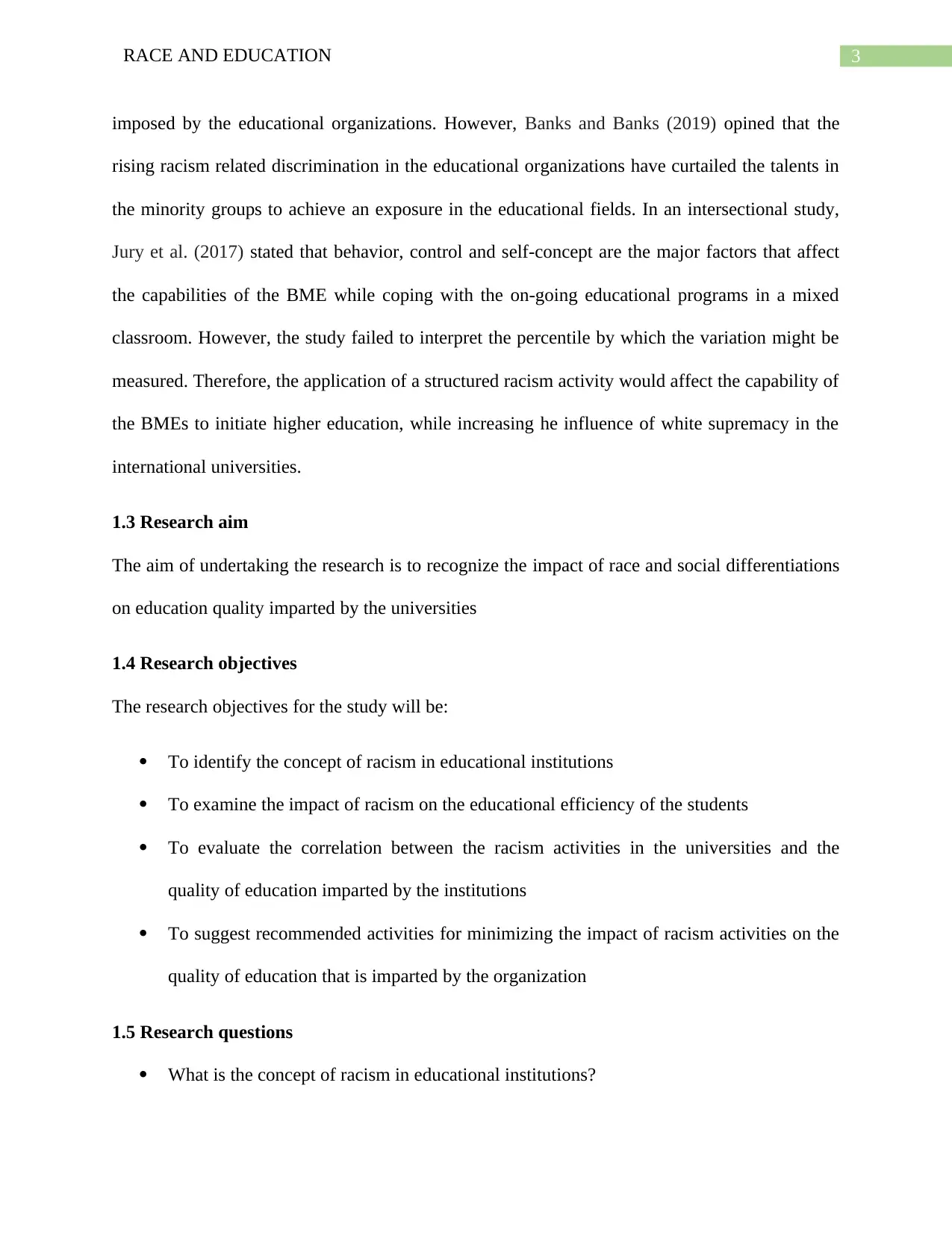
3RACE AND EDUCATION
imposed by the educational organizations. However, Banks and Banks (2019) opined that the
rising racism related discrimination in the educational organizations have curtailed the talents in
the minority groups to achieve an exposure in the educational fields. In an intersectional study,
Jury et al. (2017) stated that behavior, control and self-concept are the major factors that affect
the capabilities of the BME while coping with the on-going educational programs in a mixed
classroom. However, the study failed to interpret the percentile by which the variation might be
measured. Therefore, the application of a structured racism activity would affect the capability of
the BMEs to initiate higher education, while increasing he influence of white supremacy in the
international universities.
1.3 Research aim
The aim of undertaking the research is to recognize the impact of race and social differentiations
on education quality imparted by the universities
1.4 Research objectives
The research objectives for the study will be:
To identify the concept of racism in educational institutions
To examine the impact of racism on the educational efficiency of the students
To evaluate the correlation between the racism activities in the universities and the
quality of education imparted by the institutions
To suggest recommended activities for minimizing the impact of racism activities on the
quality of education that is imparted by the organization
1.5 Research questions
What is the concept of racism in educational institutions?
imposed by the educational organizations. However, Banks and Banks (2019) opined that the
rising racism related discrimination in the educational organizations have curtailed the talents in
the minority groups to achieve an exposure in the educational fields. In an intersectional study,
Jury et al. (2017) stated that behavior, control and self-concept are the major factors that affect
the capabilities of the BME while coping with the on-going educational programs in a mixed
classroom. However, the study failed to interpret the percentile by which the variation might be
measured. Therefore, the application of a structured racism activity would affect the capability of
the BMEs to initiate higher education, while increasing he influence of white supremacy in the
international universities.
1.3 Research aim
The aim of undertaking the research is to recognize the impact of race and social differentiations
on education quality imparted by the universities
1.4 Research objectives
The research objectives for the study will be:
To identify the concept of racism in educational institutions
To examine the impact of racism on the educational efficiency of the students
To evaluate the correlation between the racism activities in the universities and the
quality of education imparted by the institutions
To suggest recommended activities for minimizing the impact of racism activities on the
quality of education that is imparted by the organization
1.5 Research questions
What is the concept of racism in educational institutions?
Paraphrase This Document
Need a fresh take? Get an instant paraphrase of this document with our AI Paraphraser

4RACE AND EDUCATION
How does racism affect educational efficiency of the students?
How are racism activities in the UK universities correlated to the quality of education
imparted by the institutions?
What are the recommended activities for minimizing the impact of racism activities on
the quality of education that is imparted by the educational organizations?
1.6 Research hypothesis
H1- Racism and social differentiations have an effect on education quality imparted by the UK
universities
H0- Racism and social differentiations does not have any effect on education quality imparted by
the UK universities
2. Literature review
2.1 Factors affecting racial and social discrimination
Equity issues in the educational organizations have downgraded the quality of the
educational services that are being imparted by the same. Discrimination among the students
based on their race and cultural status and the inequality of educational privileges being provided
to the same by the educational institutions results to diminishing quality of the propositions.
Ghavami and Mistry (2019) stated that racial harassment and open abuse are some of the major
problems that might be faced by the BMEs while being educated in foreign universities.
According to a report published by the Equality and Human Rights Commission in UK, around
43% of the BME students and staffs were reported to be threatened by racial discrimination
(Moore‐Berg and Karpinski 2019). Moreover, the report also reflected that 9% of the white
students in the universities of UK have encountered racial harassment which paved to an “anti-
How does racism affect educational efficiency of the students?
How are racism activities in the UK universities correlated to the quality of education
imparted by the institutions?
What are the recommended activities for minimizing the impact of racism activities on
the quality of education that is imparted by the educational organizations?
1.6 Research hypothesis
H1- Racism and social differentiations have an effect on education quality imparted by the UK
universities
H0- Racism and social differentiations does not have any effect on education quality imparted by
the UK universities
2. Literature review
2.1 Factors affecting racial and social discrimination
Equity issues in the educational organizations have downgraded the quality of the
educational services that are being imparted by the same. Discrimination among the students
based on their race and cultural status and the inequality of educational privileges being provided
to the same by the educational institutions results to diminishing quality of the propositions.
Ghavami and Mistry (2019) stated that racial harassment and open abuse are some of the major
problems that might be faced by the BMEs while being educated in foreign universities.
According to a report published by the Equality and Human Rights Commission in UK, around
43% of the BME students and staffs were reported to be threatened by racial discrimination
(Moore‐Berg and Karpinski 2019). Moreover, the report also reflected that 9% of the white
students in the universities of UK have encountered racial harassment which paved to an “anti-
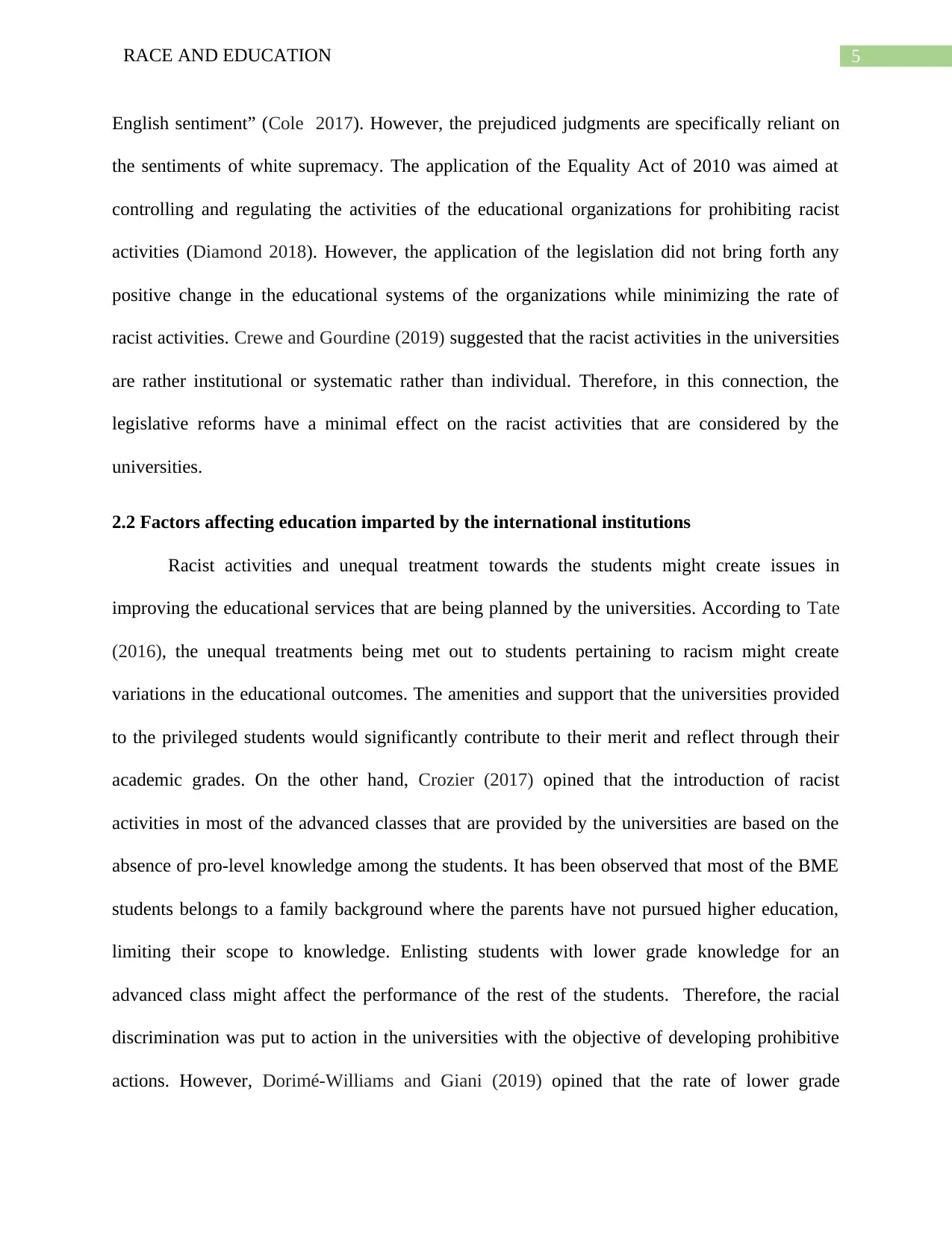
5RACE AND EDUCATION
English sentiment” (Cole 2017). However, the prejudiced judgments are specifically reliant on
the sentiments of white supremacy. The application of the Equality Act of 2010 was aimed at
controlling and regulating the activities of the educational organizations for prohibiting racist
activities (Diamond 2018). However, the application of the legislation did not bring forth any
positive change in the educational systems of the organizations while minimizing the rate of
racist activities. Crewe and Gourdine (2019) suggested that the racist activities in the universities
are rather institutional or systematic rather than individual. Therefore, in this connection, the
legislative reforms have a minimal effect on the racist activities that are considered by the
universities.
2.2 Factors affecting education imparted by the international institutions
Racist activities and unequal treatment towards the students might create issues in
improving the educational services that are being planned by the universities. According to Tate
(2016), the unequal treatments being met out to students pertaining to racism might create
variations in the educational outcomes. The amenities and support that the universities provided
to the privileged students would significantly contribute to their merit and reflect through their
academic grades. On the other hand, Crozier (2017) opined that the introduction of racist
activities in most of the advanced classes that are provided by the universities are based on the
absence of pro-level knowledge among the students. It has been observed that most of the BME
students belongs to a family background where the parents have not pursued higher education,
limiting their scope to knowledge. Enlisting students with lower grade knowledge for an
advanced class might affect the performance of the rest of the students. Therefore, the racial
discrimination was put to action in the universities with the objective of developing prohibitive
actions. However, Dorimé-Williams and Giani (2019) opined that the rate of lower grade
English sentiment” (Cole 2017). However, the prejudiced judgments are specifically reliant on
the sentiments of white supremacy. The application of the Equality Act of 2010 was aimed at
controlling and regulating the activities of the educational organizations for prohibiting racist
activities (Diamond 2018). However, the application of the legislation did not bring forth any
positive change in the educational systems of the organizations while minimizing the rate of
racist activities. Crewe and Gourdine (2019) suggested that the racist activities in the universities
are rather institutional or systematic rather than individual. Therefore, in this connection, the
legislative reforms have a minimal effect on the racist activities that are considered by the
universities.
2.2 Factors affecting education imparted by the international institutions
Racist activities and unequal treatment towards the students might create issues in
improving the educational services that are being planned by the universities. According to Tate
(2016), the unequal treatments being met out to students pertaining to racism might create
variations in the educational outcomes. The amenities and support that the universities provided
to the privileged students would significantly contribute to their merit and reflect through their
academic grades. On the other hand, Crozier (2017) opined that the introduction of racist
activities in most of the advanced classes that are provided by the universities are based on the
absence of pro-level knowledge among the students. It has been observed that most of the BME
students belongs to a family background where the parents have not pursued higher education,
limiting their scope to knowledge. Enlisting students with lower grade knowledge for an
advanced class might affect the performance of the rest of the students. Therefore, the racial
discrimination was put to action in the universities with the objective of developing prohibitive
actions. However, Dorimé-Williams and Giani (2019) opined that the rate of lower grade
⊘ This is a preview!⊘
Do you want full access?
Subscribe today to unlock all pages.

Trusted by 1+ million students worldwide
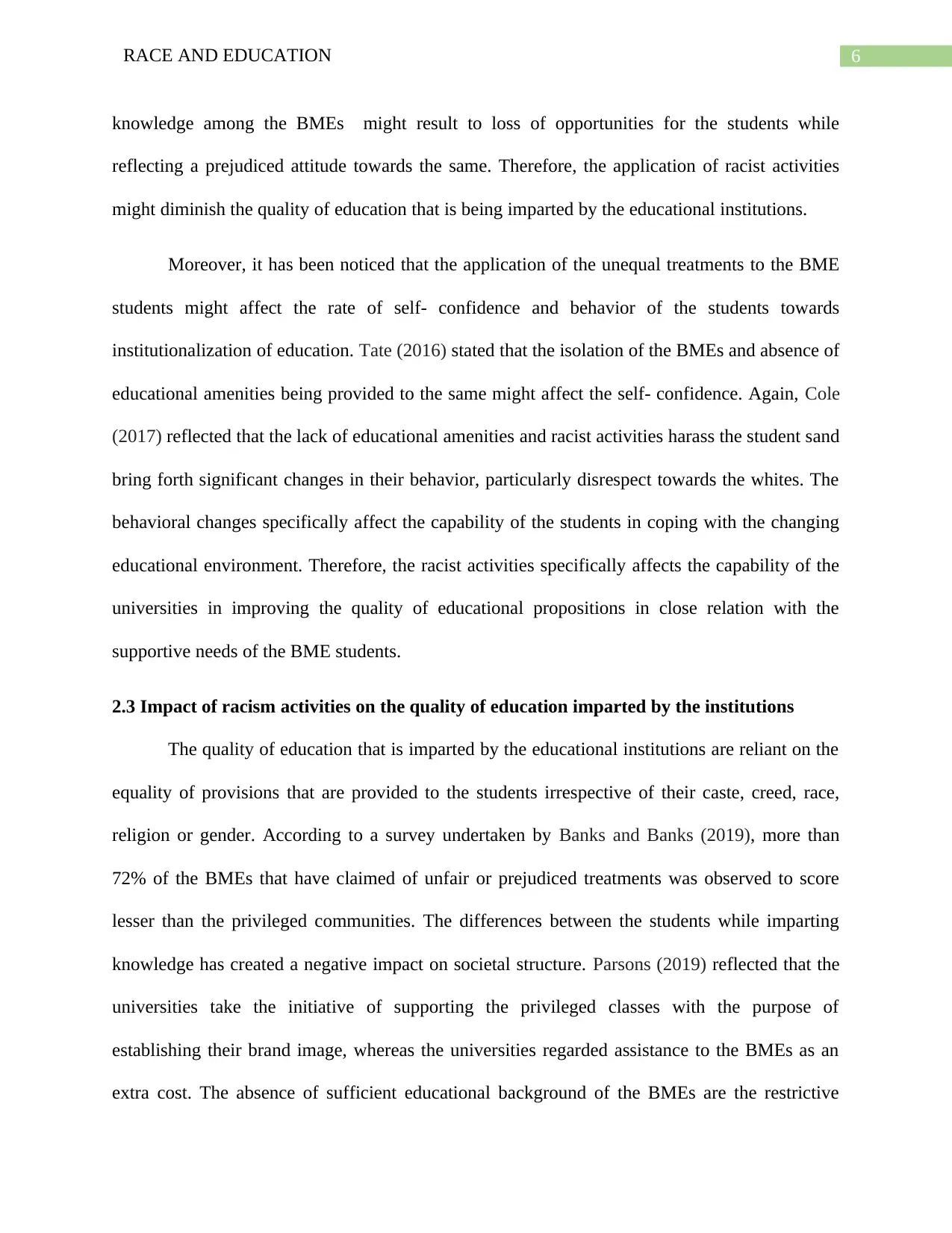
6RACE AND EDUCATION
knowledge among the BMEs might result to loss of opportunities for the students while
reflecting a prejudiced attitude towards the same. Therefore, the application of racist activities
might diminish the quality of education that is being imparted by the educational institutions.
Moreover, it has been noticed that the application of the unequal treatments to the BME
students might affect the rate of self- confidence and behavior of the students towards
institutionalization of education. Tate (2016) stated that the isolation of the BMEs and absence of
educational amenities being provided to the same might affect the self- confidence. Again, Cole
(2017) reflected that the lack of educational amenities and racist activities harass the student sand
bring forth significant changes in their behavior, particularly disrespect towards the whites. The
behavioral changes specifically affect the capability of the students in coping with the changing
educational environment. Therefore, the racist activities specifically affects the capability of the
universities in improving the quality of educational propositions in close relation with the
supportive needs of the BME students.
2.3 Impact of racism activities on the quality of education imparted by the institutions
The quality of education that is imparted by the educational institutions are reliant on the
equality of provisions that are provided to the students irrespective of their caste, creed, race,
religion or gender. According to a survey undertaken by Banks and Banks (2019), more than
72% of the BMEs that have claimed of unfair or prejudiced treatments was observed to score
lesser than the privileged communities. The differences between the students while imparting
knowledge has created a negative impact on societal structure. Parsons (2019) reflected that the
universities take the initiative of supporting the privileged classes with the purpose of
establishing their brand image, whereas the universities regarded assistance to the BMEs as an
extra cost. The absence of sufficient educational background of the BMEs are the restrictive
knowledge among the BMEs might result to loss of opportunities for the students while
reflecting a prejudiced attitude towards the same. Therefore, the application of racist activities
might diminish the quality of education that is being imparted by the educational institutions.
Moreover, it has been noticed that the application of the unequal treatments to the BME
students might affect the rate of self- confidence and behavior of the students towards
institutionalization of education. Tate (2016) stated that the isolation of the BMEs and absence of
educational amenities being provided to the same might affect the self- confidence. Again, Cole
(2017) reflected that the lack of educational amenities and racist activities harass the student sand
bring forth significant changes in their behavior, particularly disrespect towards the whites. The
behavioral changes specifically affect the capability of the students in coping with the changing
educational environment. Therefore, the racist activities specifically affects the capability of the
universities in improving the quality of educational propositions in close relation with the
supportive needs of the BME students.
2.3 Impact of racism activities on the quality of education imparted by the institutions
The quality of education that is imparted by the educational institutions are reliant on the
equality of provisions that are provided to the students irrespective of their caste, creed, race,
religion or gender. According to a survey undertaken by Banks and Banks (2019), more than
72% of the BMEs that have claimed of unfair or prejudiced treatments was observed to score
lesser than the privileged communities. The differences between the students while imparting
knowledge has created a negative impact on societal structure. Parsons (2019) reflected that the
universities take the initiative of supporting the privileged classes with the purpose of
establishing their brand image, whereas the universities regarded assistance to the BMEs as an
extra cost. The absence of sufficient educational background of the BMEs are the restrictive
Paraphrase This Document
Need a fresh take? Get an instant paraphrase of this document with our AI Paraphraser
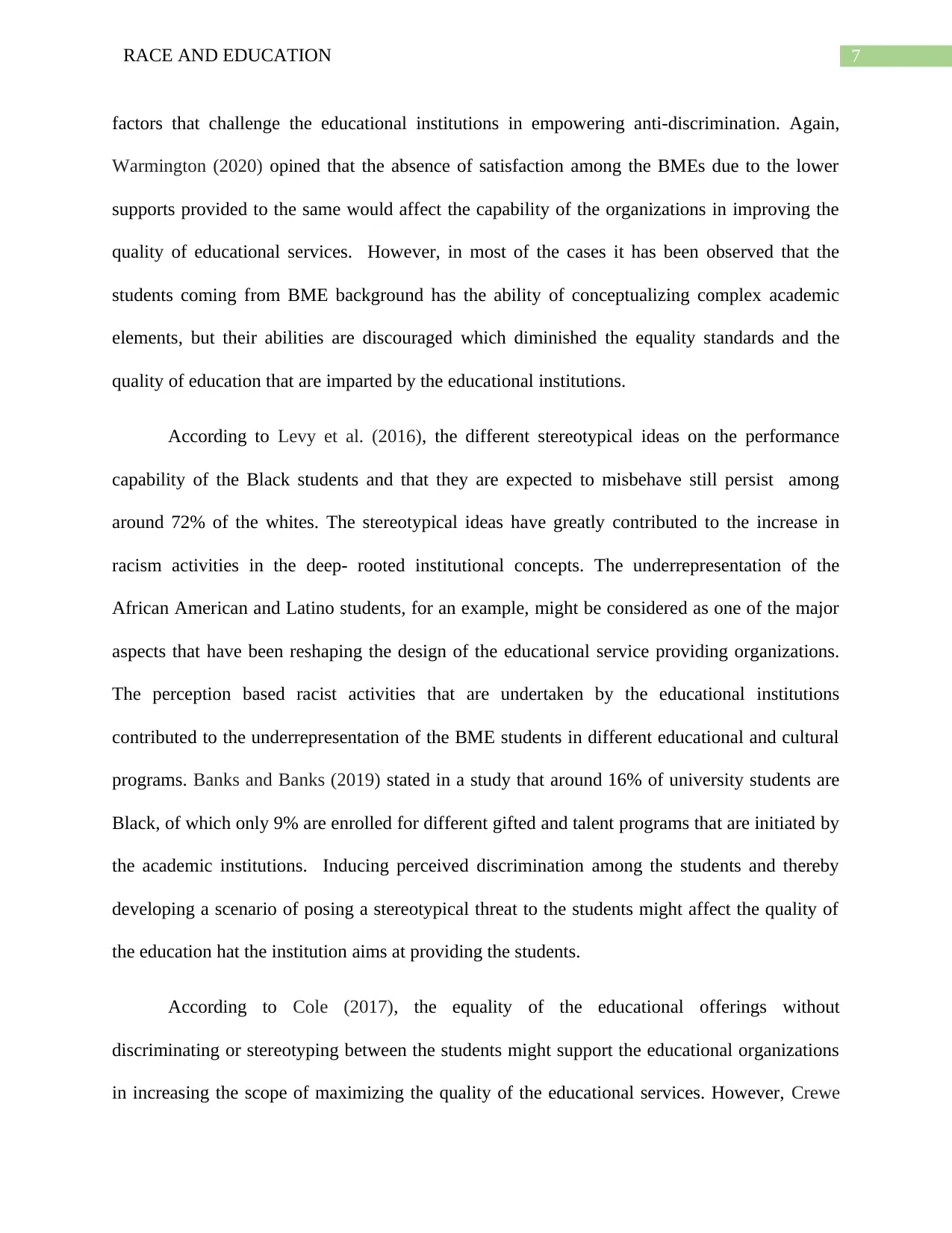
7RACE AND EDUCATION
factors that challenge the educational institutions in empowering anti-discrimination. Again,
Warmington (2020) opined that the absence of satisfaction among the BMEs due to the lower
supports provided to the same would affect the capability of the organizations in improving the
quality of educational services. However, in most of the cases it has been observed that the
students coming from BME background has the ability of conceptualizing complex academic
elements, but their abilities are discouraged which diminished the equality standards and the
quality of education that are imparted by the educational institutions.
According to Levy et al. (2016), the different stereotypical ideas on the performance
capability of the Black students and that they are expected to misbehave still persist among
around 72% of the whites. The stereotypical ideas have greatly contributed to the increase in
racism activities in the deep- rooted institutional concepts. The underrepresentation of the
African American and Latino students, for an example, might be considered as one of the major
aspects that have been reshaping the design of the educational service providing organizations.
The perception based racist activities that are undertaken by the educational institutions
contributed to the underrepresentation of the BME students in different educational and cultural
programs. Banks and Banks (2019) stated in a study that around 16% of university students are
Black, of which only 9% are enrolled for different gifted and talent programs that are initiated by
the academic institutions. Inducing perceived discrimination among the students and thereby
developing a scenario of posing a stereotypical threat to the students might affect the quality of
the education hat the institution aims at providing the students.
According to Cole (2017), the equality of the educational offerings without
discriminating or stereotyping between the students might support the educational organizations
in increasing the scope of maximizing the quality of the educational services. However, Crewe
factors that challenge the educational institutions in empowering anti-discrimination. Again,
Warmington (2020) opined that the absence of satisfaction among the BMEs due to the lower
supports provided to the same would affect the capability of the organizations in improving the
quality of educational services. However, in most of the cases it has been observed that the
students coming from BME background has the ability of conceptualizing complex academic
elements, but their abilities are discouraged which diminished the equality standards and the
quality of education that are imparted by the educational institutions.
According to Levy et al. (2016), the different stereotypical ideas on the performance
capability of the Black students and that they are expected to misbehave still persist among
around 72% of the whites. The stereotypical ideas have greatly contributed to the increase in
racism activities in the deep- rooted institutional concepts. The underrepresentation of the
African American and Latino students, for an example, might be considered as one of the major
aspects that have been reshaping the design of the educational service providing organizations.
The perception based racist activities that are undertaken by the educational institutions
contributed to the underrepresentation of the BME students in different educational and cultural
programs. Banks and Banks (2019) stated in a study that around 16% of university students are
Black, of which only 9% are enrolled for different gifted and talent programs that are initiated by
the academic institutions. Inducing perceived discrimination among the students and thereby
developing a scenario of posing a stereotypical threat to the students might affect the quality of
the education hat the institution aims at providing the students.
According to Cole (2017), the equality of the educational offerings without
discriminating or stereotyping between the students might support the educational organizations
in increasing the scope of maximizing the quality of the educational services. However, Crewe
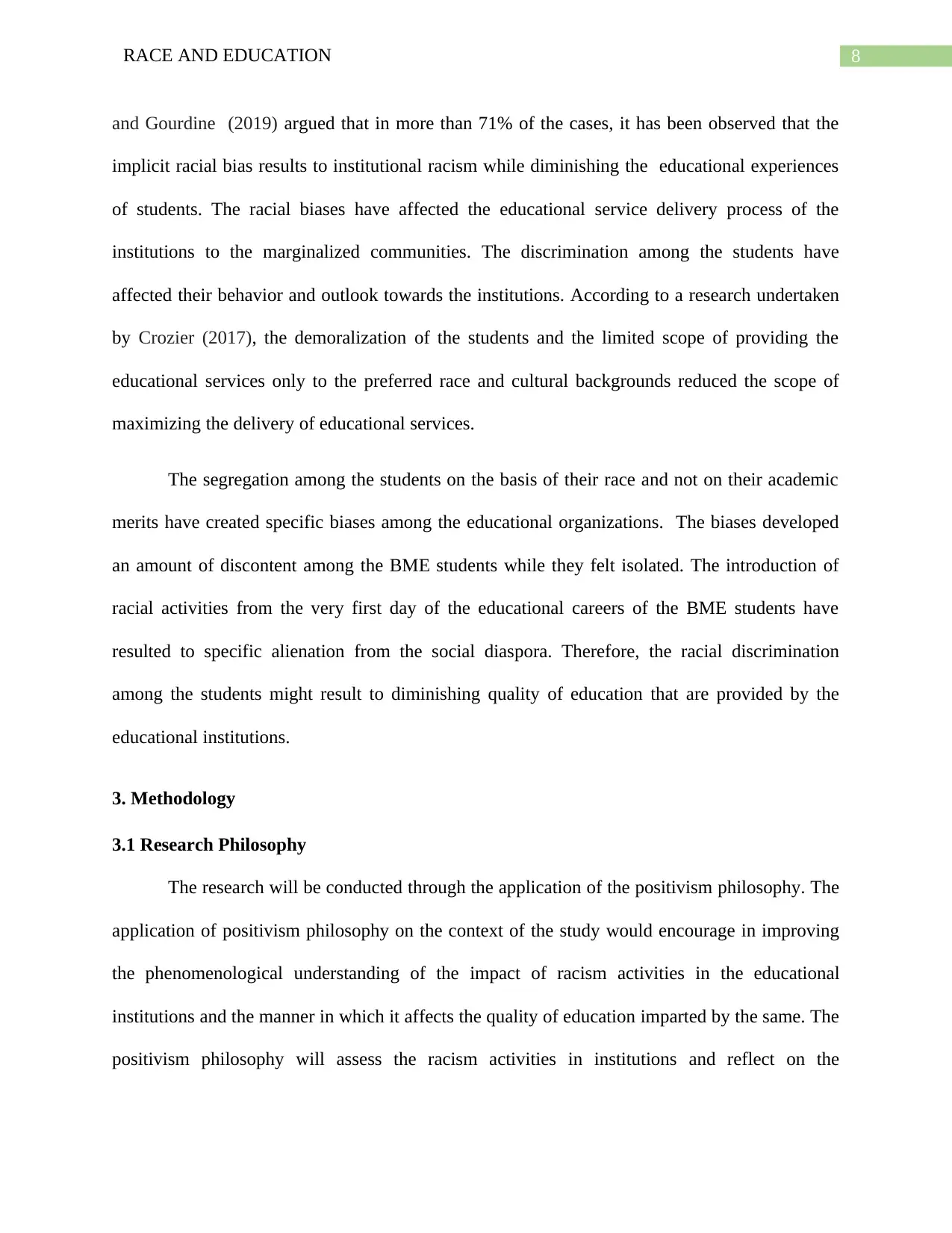
8RACE AND EDUCATION
and Gourdine (2019) argued that in more than 71% of the cases, it has been observed that the
implicit racial bias results to institutional racism while diminishing the educational experiences
of students. The racial biases have affected the educational service delivery process of the
institutions to the marginalized communities. The discrimination among the students have
affected their behavior and outlook towards the institutions. According to a research undertaken
by Crozier (2017), the demoralization of the students and the limited scope of providing the
educational services only to the preferred race and cultural backgrounds reduced the scope of
maximizing the delivery of educational services.
The segregation among the students on the basis of their race and not on their academic
merits have created specific biases among the educational organizations. The biases developed
an amount of discontent among the BME students while they felt isolated. The introduction of
racial activities from the very first day of the educational careers of the BME students have
resulted to specific alienation from the social diaspora. Therefore, the racial discrimination
among the students might result to diminishing quality of education that are provided by the
educational institutions.
3. Methodology
3.1 Research Philosophy
The research will be conducted through the application of the positivism philosophy. The
application of positivism philosophy on the context of the study would encourage in improving
the phenomenological understanding of the impact of racism activities in the educational
institutions and the manner in which it affects the quality of education imparted by the same. The
positivism philosophy will assess the racism activities in institutions and reflect on the
and Gourdine (2019) argued that in more than 71% of the cases, it has been observed that the
implicit racial bias results to institutional racism while diminishing the educational experiences
of students. The racial biases have affected the educational service delivery process of the
institutions to the marginalized communities. The discrimination among the students have
affected their behavior and outlook towards the institutions. According to a research undertaken
by Crozier (2017), the demoralization of the students and the limited scope of providing the
educational services only to the preferred race and cultural backgrounds reduced the scope of
maximizing the delivery of educational services.
The segregation among the students on the basis of their race and not on their academic
merits have created specific biases among the educational organizations. The biases developed
an amount of discontent among the BME students while they felt isolated. The introduction of
racial activities from the very first day of the educational careers of the BME students have
resulted to specific alienation from the social diaspora. Therefore, the racial discrimination
among the students might result to diminishing quality of education that are provided by the
educational institutions.
3. Methodology
3.1 Research Philosophy
The research will be conducted through the application of the positivism philosophy. The
application of positivism philosophy on the context of the study would encourage in improving
the phenomenological understanding of the impact of racism activities in the educational
institutions and the manner in which it affects the quality of education imparted by the same. The
positivism philosophy will assess the racism activities in institutions and reflect on the
⊘ This is a preview!⊘
Do you want full access?
Subscribe today to unlock all pages.

Trusted by 1+ million students worldwide
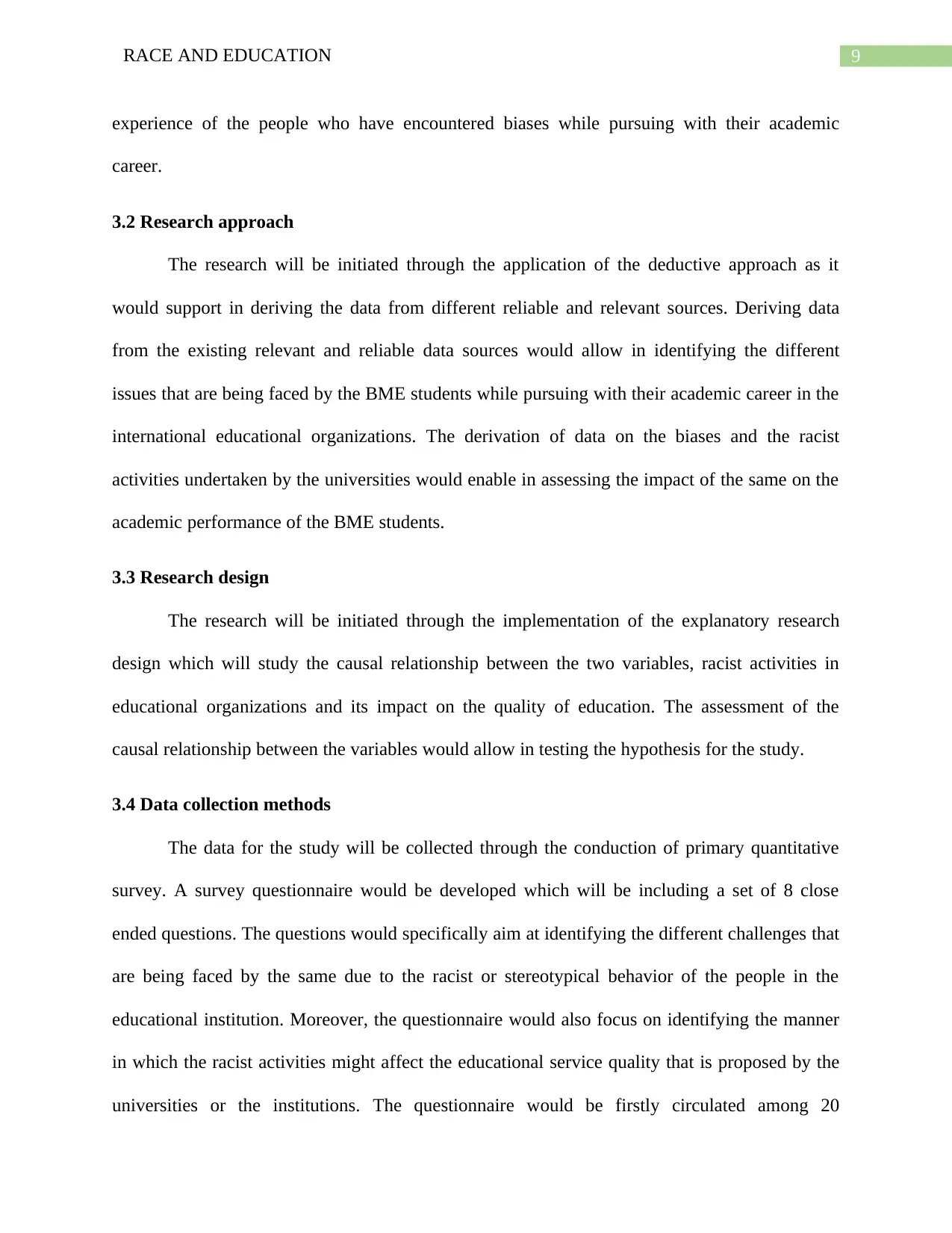
9RACE AND EDUCATION
experience of the people who have encountered biases while pursuing with their academic
career.
3.2 Research approach
The research will be initiated through the application of the deductive approach as it
would support in deriving the data from different reliable and relevant sources. Deriving data
from the existing relevant and reliable data sources would allow in identifying the different
issues that are being faced by the BME students while pursuing with their academic career in the
international educational organizations. The derivation of data on the biases and the racist
activities undertaken by the universities would enable in assessing the impact of the same on the
academic performance of the BME students.
3.3 Research design
The research will be initiated through the implementation of the explanatory research
design which will study the causal relationship between the two variables, racist activities in
educational organizations and its impact on the quality of education. The assessment of the
causal relationship between the variables would allow in testing the hypothesis for the study.
3.4 Data collection methods
The data for the study will be collected through the conduction of primary quantitative
survey. A survey questionnaire would be developed which will be including a set of 8 close
ended questions. The questions would specifically aim at identifying the different challenges that
are being faced by the same due to the racist or stereotypical behavior of the people in the
educational institution. Moreover, the questionnaire would also focus on identifying the manner
in which the racist activities might affect the educational service quality that is proposed by the
universities or the institutions. The questionnaire would be firstly circulated among 20
experience of the people who have encountered biases while pursuing with their academic
career.
3.2 Research approach
The research will be initiated through the application of the deductive approach as it
would support in deriving the data from different reliable and relevant sources. Deriving data
from the existing relevant and reliable data sources would allow in identifying the different
issues that are being faced by the BME students while pursuing with their academic career in the
international educational organizations. The derivation of data on the biases and the racist
activities undertaken by the universities would enable in assessing the impact of the same on the
academic performance of the BME students.
3.3 Research design
The research will be initiated through the implementation of the explanatory research
design which will study the causal relationship between the two variables, racist activities in
educational organizations and its impact on the quality of education. The assessment of the
causal relationship between the variables would allow in testing the hypothesis for the study.
3.4 Data collection methods
The data for the study will be collected through the conduction of primary quantitative
survey. A survey questionnaire would be developed which will be including a set of 8 close
ended questions. The questions would specifically aim at identifying the different challenges that
are being faced by the same due to the racist or stereotypical behavior of the people in the
educational institution. Moreover, the questionnaire would also focus on identifying the manner
in which the racist activities might affect the educational service quality that is proposed by the
universities or the institutions. The questionnaire would be firstly circulated among 20
Paraphrase This Document
Need a fresh take? Get an instant paraphrase of this document with our AI Paraphraser

10RACE AND EDUCATION
participants as a pilot study with the purpose of recognizing the compatibility of the
questionnaire as per the contents of the particular research. The responses from the pilot study
would be analyzed and tested for its reliability through Cronbach's alpha. After the reliability test
and significance of the result, the questionnaire would be circulated among 100 BME students
from 3 UK based educational institutions or universities. The data from the responses that are
provided by the students would be collected and analyzed simultaneously for analyzing the
variables. The overall data collection process would support in guiding the research study
towards an unbiased outcome while adhering to the objectives.
3.5 Data analysis
Reliability Statistics
Cronbach's
Alpha
Cronbach's
Alpha Based
on
Standardized
Items
N of
Items
.464 .528 15
The analysis of the gathered data will be conducted through the assessment of the
responses that are provided by 100 respondents. However, initially a pilot survey has been
conducted among 20 participants and checked for reliability through SPSS where the value of
Cronbach’s Alpha was tested. The Cronbach’s Alpha reliability test reflected a result of 0.464
which is much below the significance value 0.7. In this relation, some of the questions will be
avoided in the actual survey with the purpose of empowering the significance. The pilot survey
outcome specifically mentioned that more than 82% of the population have agreed upon the fact
that irrespective of gender they faced significant challenge due to increased racist activity in their
participants as a pilot study with the purpose of recognizing the compatibility of the
questionnaire as per the contents of the particular research. The responses from the pilot study
would be analyzed and tested for its reliability through Cronbach's alpha. After the reliability test
and significance of the result, the questionnaire would be circulated among 100 BME students
from 3 UK based educational institutions or universities. The data from the responses that are
provided by the students would be collected and analyzed simultaneously for analyzing the
variables. The overall data collection process would support in guiding the research study
towards an unbiased outcome while adhering to the objectives.
3.5 Data analysis
Reliability Statistics
Cronbach's
Alpha
Cronbach's
Alpha Based
on
Standardized
Items
N of
Items
.464 .528 15
The analysis of the gathered data will be conducted through the assessment of the
responses that are provided by 100 respondents. However, initially a pilot survey has been
conducted among 20 participants and checked for reliability through SPSS where the value of
Cronbach’s Alpha was tested. The Cronbach’s Alpha reliability test reflected a result of 0.464
which is much below the significance value 0.7. In this relation, some of the questions will be
avoided in the actual survey with the purpose of empowering the significance. The pilot survey
outcome specifically mentioned that more than 82% of the population have agreed upon the fact
that irrespective of gender they faced significant challenge due to increased racist activity in their
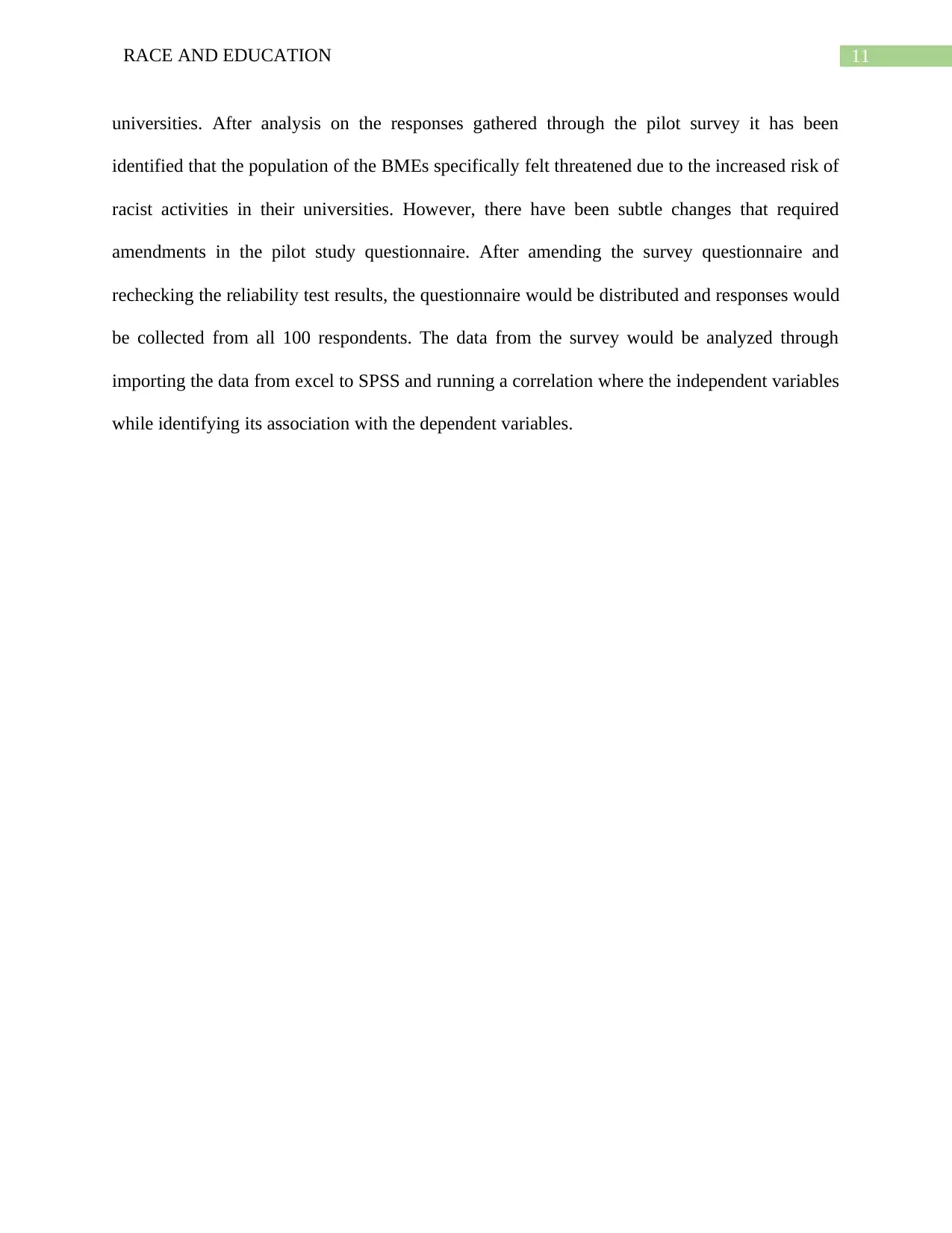
11RACE AND EDUCATION
universities. After analysis on the responses gathered through the pilot survey it has been
identified that the population of the BMEs specifically felt threatened due to the increased risk of
racist activities in their universities. However, there have been subtle changes that required
amendments in the pilot study questionnaire. After amending the survey questionnaire and
rechecking the reliability test results, the questionnaire would be distributed and responses would
be collected from all 100 respondents. The data from the survey would be analyzed through
importing the data from excel to SPSS and running a correlation where the independent variables
while identifying its association with the dependent variables.
universities. After analysis on the responses gathered through the pilot survey it has been
identified that the population of the BMEs specifically felt threatened due to the increased risk of
racist activities in their universities. However, there have been subtle changes that required
amendments in the pilot study questionnaire. After amending the survey questionnaire and
rechecking the reliability test results, the questionnaire would be distributed and responses would
be collected from all 100 respondents. The data from the survey would be analyzed through
importing the data from excel to SPSS and running a correlation where the independent variables
while identifying its association with the dependent variables.
⊘ This is a preview!⊘
Do you want full access?
Subscribe today to unlock all pages.

Trusted by 1+ million students worldwide
1 out of 17
Related Documents
Your All-in-One AI-Powered Toolkit for Academic Success.
+13062052269
info@desklib.com
Available 24*7 on WhatsApp / Email
![[object Object]](/_next/static/media/star-bottom.7253800d.svg)
Unlock your academic potential
Copyright © 2020–2025 A2Z Services. All Rights Reserved. Developed and managed by ZUCOL.





